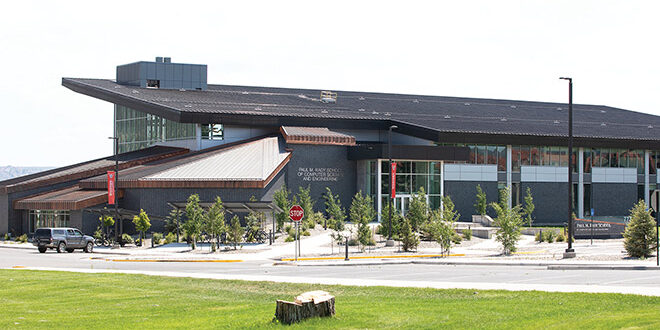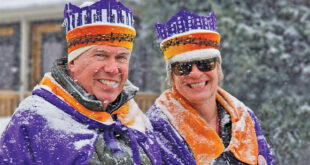Partnering with Blister, Adaptive and others in the outdoor industry
[ By Katherine Nettles ]
In its first two years the engineering and computer science partnership between Western Colorado University (WCU) and University of Colorado at Boulder (CU Boulder) has seen irrefutable success. It appears to be a star performer for WCU with increasing enrollment and also for the Gunnison Valley with its innovation and practical application to a durable local economy. With the addition of a Blister Labs outdoor industry component to the engineering program in 2022 and a growing list of collaborations the potential for the program seems to be just taking flight.
WCU’s Paul M. Rady School of Computer Science & Engineering opened in 2020 as a result of a major endowment from WCU alumnus Paul Rady. Rady, who graduated in 1978 and became the co-founder and president of Antero Resources Corporation, made a historic donation of $90 million to his alma mater in order to establish the new computer science and engineering department. His donation also served to establish a partnership program between WCU and CU Boulder, set up a scholarship fund and build an accompanying research facility on campus for it.
Graduates of the partnership program receive their Bachelor of Science in engineering from the University of Colorado Boulder’s College of Engineering & Applied Science, with computer science and mechanical engineering focuses available.
The Rady school also offers non-CU affiliated areas of focus such as actuarial science, informational security, math computer science, data analytics, scientific computing, web design and more.
Department director Jenifer Blacklock, who previously directed the advanced manufacturing program at Colorado School of Mines and arrived at WCU in 2020 to establish the new program, attests to the innovative work happening there—both on and off campus.
“We actually have our first graduating class of 20 or so happening in May 2023,” she reports. That cohort is made up of 15 students pursuing mechanical engineering degrees and five pursuing computer science degrees. While most engineering degrees are considered five-year degrees due to their rigor, this cohort will finish in four.
“It was such a small cohort that we are able to guide the students through. But that is not normal for an engineering degree,” says Blacklock. There are now around 200 total students in the partnership program after just two years of operation.
Blacklock adds that a few among the group are adding MBA pursuits to their engineering degree, as a four-plus-one year program. “There are very few programs in the country doing that, I think.”
The Rady school saw a 17% enrollment increase in 2022, with 73 new students added in 2021 and 87 new students added in 2022. “Which is incredible, most universities are not seeing that right now,” says Blacklock. She notes that a large portion of that increase is due to students transferring from elsewhere because of the engineering partnership opportunity.
Real world research
Several in the 2024 cohort are also pursuing an outdoor industry MBA degree (OIMBA), which gives students real-world experience on projects within the Gunnison Valley.
Blacklock describes a successful collaboration with Crested Butte’s Adaptive Sports Center (ASC) over the past two years, working on redesigning recumbent hand bikes for the adaptive community.
“Students work with ASC and the adaptive community on engineering more efficient bikes for gravel biking and commuting around town. These bikes will eventually be donated to ASC for testing to continue to advance the design of these bikes for future riders. Other partners for this project include SRAM, Specialized and CeramicSpeed,” explains Blacklock.
In January 2022, another partnership called Blister Labs launched between WCU, CU Boulder and the outdoor gear review company Blister that is based in Mt. Crested Butte. The partnership makes further use of the Rady engineering facility and associated faculty and students to participate in outdoor industry research. Partnering outdoor industry companies and organizations develop prototypes and troubleshoot designs and WCU students participate in such projects alongside the professionals.
Jonathan Ellsworth, founder of Blister, describes the partnership as a first of its kind, and one he had been brainstorming since he founded Blister about 12 years ago.
“I thought it would be very useful when studying the mechanics of all this expensive outdoor equipment and marry that to qualitative data,” he says. “This is the world’s first outdoor industry engineering program, right here in Gunnison. And it’s been a remarkable first year.
“We are working with brilliant faculty members at the WCU/CU campuses, a brilliant team of engineers, an amazing state of the art facility that is the Rady building and our company’s 12 years of experience reviewing products in the outdoor industry…it really feels like a perfect marriage of these entities,” continues Ellsworth.
Blacklock describes that Blister is bringing the program other outdoor industry partners as well. “We have a dynamic modeling system that other companies just don’t have because we’re bringing the research component of their business to our campus facility. That includes robotics, data analytics, mechanical design, fabrication and then we’re all outdoor enthusiasts, so we all get it,” she says of the synergy between students and employers.
Ellsworth says the range of disciplines in engineering available through the Rady facility and the WCU/CU partnership is rare. “We are bringing so many different types of engineers to tackle different problems and different issues—which particularly in the area of dynamic modeling, is extremely uncommon.”
“It’s been great for companies and it has been so exciting for our students as well,” says Blacklock. “It’s all part of the equation of establishing this whole valley as an outdoor industry hub.”
According to a recent survey over half the students on campus are interested in participating in these outdoor industry projects. The program is also attracting high quality students, with an average high school GPA of 3.75.
“I like to call them wholehearted students,” says Blacklock. “They care a lot about their education, but they also take on a lot of ownership and responsibility for their performance and I think that’s unique. They are amazing to work with and to teach. And it being small, we know each of them by name, and what they like. And we have 95% internship placement for them. Having these smaller classes really allows us to engage with students, and they are on track to pursue what they are passionate about.”
And she says she believes that helps advance WCU overall, from students to faculty. For the second year in a row, the WCU campus saw notable gains in first-to-second-year retention of new students, which increased by more than two percentage points to 76%.
WCU and CU a good fit
“We’re helping to elevate the capital campaign of WCU in bringing excellence here. And CU Boulder has been really supportive of our program and of WCU. It is innovative and creative and we work together very well,” says Blacklock. “We’re getting the best of the best who just happen to love the outdoors.”
Blacklock recognizes that the fast pace of developing and growing these new programs have not been all smooth sailing. “You know, it is different. And a lot of people are challenged by something different. But everyone has been open minded. And a lot of it comes down to recognizing how it can help our community grow, and how it can help our university grow and what it can do for the valley.”
In fact, Blacklock says some local, non-traditional students have recently enrolled in the engineering program to advance their skills. “It gives opportunities to the current workforce. I think people can feel in a small community that you’re stuck, and this creates opportunity for everyone.”
Blacklock says she hopes to bring other students into the program from the community and from around the state. She notes that the CU Boulder partnership degree costs about 50% less than going to the CU Boulder campus, because students pay WCU tuition the first two years, and because the Rady school has provided generous scholarships through private donors, private industry partnerships and from the university.
A Rady scholarship has provided full tuition for students entering the program calculus-ready and with 3.5 GPA from high school but will soon transition to a more traditional merit structure.
“We’re able to do things that other schools aren’t able to do,” reflects Blacklock. “And we have one of the nicest facilities in the state.”
 The Crested Butte News Serving the Gunnison Valley since 1999
The Crested Butte News Serving the Gunnison Valley since 1999




